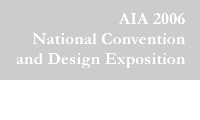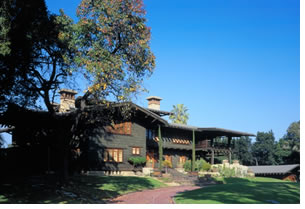

5/2006
Greene & Greene masterpiece subject of AIA national convention, reflection

by Tracy Ostroff
The Gamble House is “one of the best crafted pieces of architecture in the U.S., and certainly one of the very best houses ever built. When a young architecture student enjoys the experience of spending a year in residence, it is truly a daunting realization, when moving out, to come to terms with the fact that in your entire life you may never live as well again,” says Ronald Altoon, FAIA, partner, Altoon + Porter, about Charles and Henry Greene’s masterwork in Pasadena, Calif. Altoon was the home’s first scholar in residence during his 1967–1968 academic year at the University of Southern California, which now operates the house.
 “It was great to live there alone. Waking early to watch the sun rise was magical. Watching the setting sun over the Arroyo Seco in late spring produced equal awe. I was able to explore every nook and cranny of the house at my leisure and consume its most subtle nuances and let it reveal to me its most sacred secrets,” Altoon recalls. “I was, in effect, the assistant curator with responsibilities to participate in researching and implementing a painting scheme to restore the original color palette to the interior walls of the house. I was also chief custodian, trash remover, and furniture mover, which generally necessitated carrying 50–75 folding chairs from the basement to the attic room three flights up and back down the next day,” he says.
“It was great to live there alone. Waking early to watch the sun rise was magical. Watching the setting sun over the Arroyo Seco in late spring produced equal awe. I was able to explore every nook and cranny of the house at my leisure and consume its most subtle nuances and let it reveal to me its most sacred secrets,” Altoon recalls. “I was, in effect, the assistant curator with responsibilities to participate in researching and implementing a painting scheme to restore the original color palette to the interior walls of the house. I was also chief custodian, trash remover, and furniture mover, which generally necessitated carrying 50–75 folding chairs from the basement to the attic room three flights up and back down the next day,” he says.
Altoon founded the Friends of The Gamble House in 1969 upon his return to Los Angeles from Philadelphia, where he was earning his MArch at the University of Pennsylvania. “I wrote the bylaws and was the first president. I no longer have a formal role, but I was called upon when Partners in Preservation formed a board to raise several million dollars to completely restore the house, recently completed.”
That renovation is the subject “Integrating Science, Art, and Construction at the Gamble House,” a special seminar on Thursday, June 8, at the AIA national convention in Los Angeles. The question is, Moderator Peyton Hall, FAIA, posits, “if we think of the Gamble House as a work of architectural art, then how do we practically speaking bring art conservation standards to analyzing the house, making drawings and specifications, and then executing in the field with a competitive-bid-qualified contractor?”
“Highest level of practice”
Hall and HRG, a multidisciplinary historic preservation consulting firm, have been tackling that question on this project since beginning the initial historic structure report they completed in 2000. For that report, HRG, surveyed the history and conditions of the building, making recommendations for immediate treatment and future preservation efforts. The follow-up to that was the Gamble House preservation project, completed in 2004.
The Gamble House executive director and an architectural conservator will join Hall at the talk. “One of the main underlying themes is how we integrate these two allied professions—art conservation and architecture—so that we bring the highest level of practice to both,” Hall notes. This is an important aspect of collaboration to study, he says, because “we’re building bridges with allied professions so that we can use the highest level of expertise where we need it.”
He says this idea applies to all architectural fields and “to many historic preservation projects that now have conservators on the team with the architect and the contractor in terms of assessing and treating particular materials. The architect still leads the team, but we welcome special expertise in other fields. Then we learn and invent ways to integrate these disciplines into the whole design and construction process.”
 Ongoing stewardship
Ongoing stewardship
To appreciate the importance of art-quality building restoration, one needs to have the perspective of a steward, such as Ted Bosley, director of the Gamble House organization, Hall contends. “Stewardship is forever. So understanding the condition, maintenance, and treatment of the house is necessary for the long-term survival of the house. What we will be presenting in Los Angeles is a particular conservation project for the outside of the house. It’s about a one-year exercise. My perspective on the Gamble House itself, though, is not of a one-year project but of a continuing responsibility of stewardship.”
To facilitate that continuity, HRG produced the historic structure report in both a bound book and a FileMaker Pro database. “Rather than being a static report that sits on the shelf, it’s really a facility management tool that sits on the desktop of the building steward to use and add to. It’s a living document rather than a doorstop,” Hall says.
Architect of Record Kelly Sutherlin McCloud, with whom HRG worked, added another dimension of understanding of the building, Hall notes. Like Altoon, McCloud was a Gamble House Scholar while an architecture student at the University of Southern California and lived at the house for an academic term.
Expert recommendations
What do the experts recommend paying attention to at the Gamble House? “Craftsmen-era houses utilize forces of nature to make the living experience as comfortable as possible. The three second-floor sleeping porches offered a summer outdoor sleeping alternative, and the placement of windows and breezeway openings within the house allowed summer temperatures to fall significantly with cross ventilation breezes doing most of the work.”
Hall also looks up for his favorite element. “Whereas all of us, and particularly the layman, would be easily drawn to the beautifully sculpted and finished interior teak finishes, having looked so closely to the Gamble House, I am really drawn to its roof structure—its rafters. What I find at the Gamble House is that unlike your hundreds of bungalows that have beautifully simple open rafters that extend out under the eaves of the house, the house and garage of the Gamble House have beautifully sculpted rafters that are not uniformly spaced; rather, they are spaced in some cases to reflect the structure of the building. They also vary in the depth and size based on the spans they are covering. They reflect the structural needs of this building in a sublimely beautiful way. It’s the integration of function and form.”
 Architectural ghosts and Gamble House scholars
Architectural ghosts and Gamble House scholars
Altoon says the Gamble House “has influenced how I approach residential design, and how materials are joined together.”
His favorite story about the house shows that it may have had another effect on him. “Mr. and Mrs. Gamble commissioned the house from Greene & Greene and promptly left for an extended trip to the Orient,” Altoon says. “The house was ready upon their return, but contained a billiard room (apparently added by the architects) on the top floor. Mrs. Gamble, being of devout faith, refused to allow an instrument of gambling to enter her house, so the room was left incomplete, with the light fixtures still dangling from their electrical cords.
“An elderly maiden aunt, Julia, moved in as well. Her photograph still graces the room that had been her own. She did not trust the new-fangled concept of ‘forced air’ heating, so a potbelly stove was to be installed and connected to the fireplace flue. But, to her delight, it was never needed as the modern mechanical system did very well indeed.
“While I lived there, several friends and I tried to contact Aunt Julia, long dead, through an ersatz séance, conducted in the darkened living room. All of a sudden a ghostlike figure appeared from out of the bushes in the backyard, lit only by the reflected light of the full moon, and darted back and forth across the lawn. It wasn't Julia, but it was there, witnessed by eight people. True story.”
Copyright 2006 The American Institute of Architects.
All rights reserved. Home Page ![]()
![]()
Tour the Gamble House during your stay in Southern California when you attend the AIA National Convention and Design Expo in Los Angeles, June 8–10. ![]()
Can’t get to the convention? Visit the Gamble House online.
The Gamble House, a National Historic Landmark, is now owned by the City of Pasadena and operated by the University of Southern California.
To register for “Integrating Science, Art, and Construction at
the Gamble House,” (TH56) taking place Thursday, June 8, 4-5:30
p.m., visit the AIA Convention Web site. ![]()
Photography by Alexander Vertikoff.
![]()